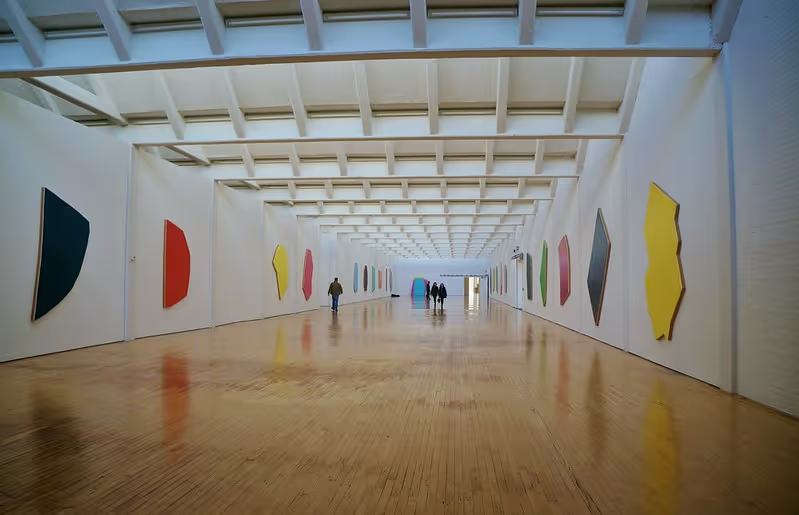Imi Knoebel: Minimalist and Color Magician

Bright colors, clear forms, ordinary materials and light: Imi Knoebel is a world-renowned German artist who can create fascinating paintings, sculptures and objects from simple things. Learn more about the “color magician”, whose oeuvre ranges from paintings to stained-glass windows to the design of a bar in Basel.
Imi Knoebel aka Klaus Wolf Knoebel
Klaus Wolf Knöbel, born in Dessau in 1949, became a world-famous artist under the pseudonym Imi Knöbel. He studied at the Düsseldorf Academy in the class of Joseph Beuys and, together with Rainer Giese, claimed the legendary Room 19, which became a space for artistic experiments for the two of them. Their deep connection prompted Klaus Wolf Knöbel and Rainer Giese to share an artistic identity - both took on the same first name: Imi + Imi was intended to symbolize the phrase “Ich mit ihm”.
Together with Giese and Blinky Palermo Knoebel formed a minimal art movement among Beuys students. However, while his teacher Joseph Beuys promoted the radical change in the concept of art and society, Imi Knoebel addressed the liberation of art from all content and functions.
Knöbel received an honorary doctorate from the Friedrich Schiller University in Jena in 2006, received important art awards and has exhibited throughout Europe, in Japan and the United States. His works can be found in the collections of many important museums, including the Museum of Modern Art in New York, the Centre Pompidou in Paris and the Stedelijk Museum in Amsterdam.
In Capital magazine's art compass - the “only reliable measurement instrument for contemporary art” according to the Wall Street Journal - Knoebel was in 10th place among the most important living artists in 2022 and is also known as a color magician.
From black lines to colorful shapes
Because Knoebel's works often consist of brightly colored geometric forms, which he arranges in dynamic and sometimes irregular compositions. He is known for using simple materials such as wood, metal, and paper, which he cuts, paints and assembles into complex and visually impressive works of art. However, his color style changed over the course of his creative period from black/white to rust and bright colors.
After years of black and white painting, he took on the “inheritance” of his fellow student Blinky Palermo - the color artist from the class of Joseph Beuys, who died early. The first colored works were hardfiber paintings painted with mennige (an anti-rust agent), but from 1977 Imi painted with the entire color palette.
Since the beginning of the 1980s, Imi Knoebel's work has also been increasingly involved in political and social issues. For example, in 1988 he created the Children's Star — a work of art that continues to campaign for children's rights today by financing projects for children in need. Knoebel's work “Day and Night” is a series of sculptures that he built in a former slate mine in the Eifel. The installation consists of several pieces of wood arranged in a circle and serve as a memorial to the people who worked in the mines in the past.
Over time, an extensive collection of picture installations was also created. Stretcher frames and geometric shapes made of wood fiber boards together form a spatial structure that looks even more intense thanks to bright colors. The spatial depth of his picture installations is also due to the fact that Knoebel prefers to paint with acrylic on aluminum and allows the cool white metal of the underlying layers to shimmer through.
Well-known works
His love for transparency and color was also reflected in a very special project: With Design of a total of nine colorful stained glass windows for the venerable cathedral of Reimes In 2011, Knoebel set an example for neighbourly, French-German relations. Three other windows decorated with stained glass creations are located in the cathedral's Jean d'Arc chapel. They were inaugurated on May 11, 2015.
For the bar at Volkshaus Basel, Knoebel created the second glass window work of his career so far. Die “Imi Bar” is the only place besides the cathedral in Reims where the artist's stained glass windows can be seen. The new heart of the well-known Basel bar are the stained-glass windows designed by Knoebel exclusively for Volkshaus Basel, which colorfully celebrate the city of Basel — and drinking pleasure.
By the way, the most expensive painting by Imi Knoebel ever auctioned off is very reminiscent of the stained glass windows of the Imi Bar. It is titled “Revolver I” and was estimated at a maximum of 120,000 euros at Christie's in Amsterdam - but finally changed hands for 423,000 euros.
Stylistically similar editions with acrylic on plastic film bear the title Basel window (2020). They were produced by Financial Times honored as the star of Art Basel 2021. The only auction of a Basel window motif so far took place during the Dorotheum Art Auction in 2022 for 83,200 euros; from March 2023, will four signed and numbered works exclusively on the FINEXITY marketplace offered in the form of digitized shares.



